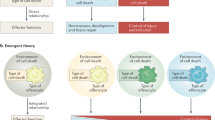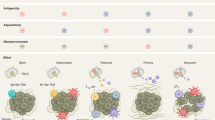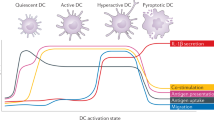Abstract
In infections, microbial components provide signals that alert the immune system to danger and promote the generation of immunity1,2. In the absence of such signals, there is often no immune response or tolerance may develop. This has led to the concept that the immune system responds only to antigens perceived to be associated with a dangerous situation such as infection3,4. Danger signals are thought to act by stimulating dendritic cells to mature so that they can present foreign antigens and stimulate T lymphocytes2,5,6,7. Dying mammalian cells have also been found to release danger signals of unknown identity8,9,10,11. Here we show that uric acid is a principal endogenous danger signal released from injured cells. Uric acid stimulates dendritic cell maturation and, when co-injected with antigen in vivo, significantly enhances the generation of responses from CD8+ T cells. Eliminating uric acid in vivo inhibits the immune response to antigens associated with injured cells, but not to antigens presented by activated dendritic cells. Our findings provide a molecular link between cell injury and immunity and have important implications for vaccines, autoimmunity and inflammation.
This is a preview of subscription content, access via your institution
Access options
Subscribe to this journal
Receive 51 print issues and online access
$199.00 per year
only $3.90 per issue
Buy this article
- Purchase on Springer Link
- Instant access to full article PDF
Prices may be subject to local taxes which are calculated during checkout






Similar content being viewed by others
References
Hunter, R. L. Overview of vaccine adjuvants: present and future. Vaccine 20 (suppl. 3), S7–S12 (2002)
Janeway, C. A. Jr Approaching the asymptote? Evolution and revolution in immunology. Cold Spring Harb. Symp. Quant. Biol. 54, 1–13 (1989)
Janeway, C. A. Jr The immune system evolved to discriminate infectious nonself from noninfectious self. Immunol. Today 13, 11–16 (1992)
Matzinger, P. Tolerance, danger, and the extended family. Annu. Rev. Immunol. 12, 991–1045 (1994)
Cox, J. C. & Coulter, A. R. Adjuvants—a classification and review of their modes of action. Vaccine 15, 248–256 (1997)
Schijns, V. E. Immunological concepts of vaccine adjuvant activity. Curr. Opin. Immunol. 12, 456–463 (2000)
Medzhitov, R. & Janeway, C. Jr Innate immune recognition: mechanisms and pathways. Immunol. Rev. 173, 89–97 (2000)
Albert, M. L., Sauter, B. & Bhardwaj, N. Dendritic cells acquire antigen from apoptotic cells and induce class I-restricted CTLs. Nature 392, 86–89 (1998)
Gallucci, S., Lolkema, M. & Matzinger, P. Natural adjuvants: endogenous activators of dendritic cells. Nature Med. 5, 1249–1255 (1999)
Shi, Y., Zheng, W. & Rock, K. L. Cell injury releases endogenous adjuvants that stimulate cytotoxic T cell responses. Proc. Natl Acad. Sci. USA 97, 14590–14595 (2000)
Shi, Y. & Rock, K. L. Cell death releases endogenous adjuvants that selectively enhance immune surveillance of particulate antigens. Eur. J. Immunol. 32, 155–162 (2002)
Jeha, S. Tumor lysis syndrome. Semin. Hematol. 38, 4–8 (2001)
Smyth, C. J. & Holers, V. M. Gout, Hyperuricemia, and Other Crystal-Associated Arthropathies (Marcel Dekker, New York, 1998)
Kippen, I., Klinenberg, J. R., Weinberger, A. & Wilcox, W. R. Factors affecting urate solubility in vitro. Ann. Rheum. Dis. 33, 313–317 (1974)
Iwata, H., Nishio, S., Yokoyama, M., Matsumoto, A. & Takeuchi, M. Solubility of uric acid and supersaturation of monosodium urate: why is uric acid so highly soluble in urine? J. Urol. 142, 1095–1098 (1989)
Fiddis, R. W., Vlachos, N. & Calvert, P. D. Studies of urate crystallisation in relation to gout. Ann. Rheum. Dis. 42 (suppl. 1), 12–15 (1983)
Tak, H. K., Cooper, S. M. & Wilcox, W. R. Studies on the nucleation of monosodium urate at 37 °C. Arthritis Rheum. 23, 574–580 (1980)
Loeb, J. N. The influence of temperature on the solubility of monosodium urate. Arthritis Rheum. 15, 189–192 (1972)
Talbott, J. H. & Yu, T.-F. Gout and Uric Acid Metabolism (Stratton Intercontinental Medical Book Corp., New York, 1976)
Yagnik, D. R. et al. Noninflammatory phagocytosis of monosodium urate monohydrate crystals by mouse macrophages. Implications for the control of joint inflammation in gout. Arthritis Rheum. 43, 1779–1789 (2000)
Landis, R. C. et al. Safe disposal of inflammatory monosodium urate monohydrate crystals by differentiated macrophages. Arthritis Rheum. 46, 3026–3033 (2002)
Koka, R. M., Huang, E. & Lieske, J. C. Adhesion of uric acid crystals to the surface of renal epithelial cells. Am. J. Physiol. Renal Physiol. 278, F989–F998 (2000)
Majno, G. & Joris, I. Cells, Tissues, and Disease: Principles of General Pathology (Blackwell Science, Cambridge, MA, 1996)
Bosmansky, K. & Trnavsky, K. Serum uric acid levels in disorders of the rheumatic type. Z. Rheumatol. 43, 59–62 (1984)
Vidard, L. et al. Analysis of MHC class II presentation of particulate antigens of B lymphocytes. J. Immunol. 156, 2809–2818 (1996)
Coligan, J. E., Kruisbeek, A. M., Margulies, D. H., Shevach, E. M. & Strober, W. Current Protocols in Immunology (Jon Wiley & Sons, Hoboken, NJ, 1991)
Acknowledgements
We thank J. Sodrosky, J. Berzofsky, N. Sato, Y. Takeda and T. Vedvick for reagents; B. Zhang, P. Furcinitti and B. Kobertz for advice and technical assistance; and L. Stern and I. York for critically reviewing the manuscript. The work was supported by NIH grants to K.L.R. Y.S. was also supported by a grant from the Pittsfield TB association.
Author information
Authors and Affiliations
Corresponding author
Ethics declarations
Competing interests
The authors declare that they have no competing financial interests.
Rights and permissions
About this article
Cite this article
Shi, Y., Evans, J. & Rock, K. Molecular identification of a danger signal that alerts the immune system to dying cells. Nature 425, 516–521 (2003). https://doi.org/10.1038/nature01991
Received:
Accepted:
Published:
Issue Date:
DOI: https://doi.org/10.1038/nature01991
This article is cited by
-
The effect of danger-associated molecular patterns on survival in acute graft versus host disease
Bone Marrow Transplantation (2024)
-
PVA /PDA@g-C3N4 Composite Nanofiber Membranes for Enhanced Photocatalytic Bacteriostasis and Degradation
Journal of Polymers and the Environment (2024)
-
Risk factors for diabetic ketoacidosis in acute pancreatitis patients with type 2 diabetes
BMC Gastroenterology (2023)
-
Hyperuricemia is accompanied by elevated peripheral CD4+ T cells
Scientific Reports (2023)
-
Advances on the early cellular events occurring upon exposure of human macrophages to aluminum oxyhydroxide adjuvant
Scientific Reports (2023)
Comments
By submitting a comment you agree to abide by our Terms and Community Guidelines. If you find something abusive or that does not comply with our terms or guidelines please flag it as inappropriate.



